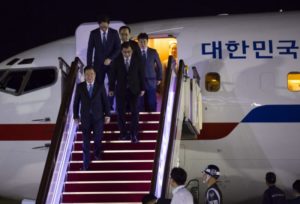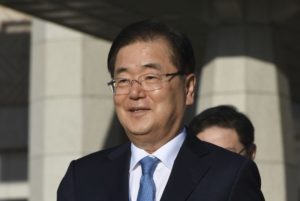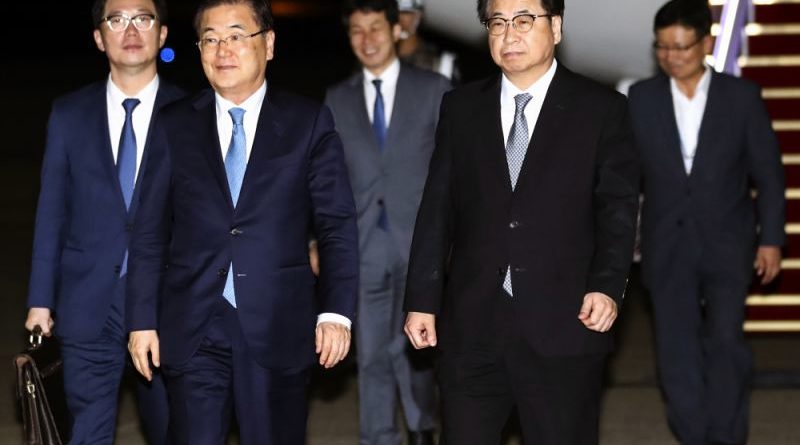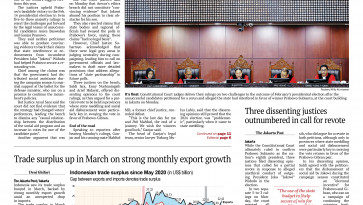NUCLEAR DISARMAMENT-KOREAS: North’s media say Kim vows nuclear-free Korea amid standoff
1/6- South Korean National Security Advisor Chung Eui-yong, center left, National Intelligence Service Director Suh Hoon, center right, and other delegates return from North Korea at Seoul Airport in Seongnam, South Korea, Wednesday, Sept. 5, 2018. A South Korean delegation met with North Korean leader Kim Jong Un on Wednesday during a visit to arrange an inter-Korean summit planned for this month and help rescue faltering nuclear diplomacy between Washington and Pyongyang.(Yun Dong-jin/Yonhap via AP)
.
SEOUL, South Korea (AP) — North Korean leader Kim Jong Un reaffirmed his commitment to a nuclear-free Korean Peninsula amid a growing standoff with the United States, his state-controlled media reported Thursday after a South Korean delegation met him to set up an inter-Korean summit.
The statement from the Korean Central News Agency wasn’t new information — Kim has repeatedly declared similar intentions before — but allows hopes to rise that diplomacy can get back on track after the recriminations that followed Kim’s meeting in June with U.S. President Donald Trump in Singapore. The impasse between North Korea and the United States, with neither side seemingly willing to make any substantive move, has generated widespread skepticism over Trump’s claims that Kim is intent on dismantling his nuclear weapons program.
.
 2/6- South Korean National Security Advisor Chung Eui-yong, bottom left, National Intelligence Service Director Suh Hoon, bottom second from left, and other delegates return from North Korea at Seoul Airport in Seongnam, South Korea, Wednesday, Sept. 5, 2018. A South Korean delegation met with North Korean leader Kim Jong Un on Wednesday during a visit to arrange an inter-Korean summit planned for this month and help rescue faltering nuclear diplomacy between Washington and Pyongyang.(Yun Dong-jin/Yonhap via AP)
2/6- South Korean National Security Advisor Chung Eui-yong, bottom left, National Intelligence Service Director Suh Hoon, bottom second from left, and other delegates return from North Korea at Seoul Airport in Seongnam, South Korea, Wednesday, Sept. 5, 2018. A South Korean delegation met with North Korean leader Kim Jong Un on Wednesday during a visit to arrange an inter-Korean summit planned for this month and help rescue faltering nuclear diplomacy between Washington and Pyongyang.(Yun Dong-jin/Yonhap via AP)
.
 3/6- Chung Eui-yong, head of the presidential National Security Office, walks to board an aircraft as he and others in a delegation leave for Pyongyang, North Korea, at a military airport in Seongnam, south of Seoul, South Korea, Wednesday, Sept. 5, 2018. The high-level South Korean delegation left for North Korea to discuss arrangements for an inter-Korean summit there this month, as relations grow cooler between Washington and Pyongyang. (Jung Yeon-je/Pool Photo via AP)
3/6- Chung Eui-yong, head of the presidential National Security Office, walks to board an aircraft as he and others in a delegation leave for Pyongyang, North Korea, at a military airport in Seongnam, south of Seoul, South Korea, Wednesday, Sept. 5, 2018. The high-level South Korean delegation left for North Korea to discuss arrangements for an inter-Korean summit there this month, as relations grow cooler between Washington and Pyongyang. (Jung Yeon-je/Pool Photo via AP)
.
 4/6- A TV screen shows a photo of South Korean President Moon Jae-in and North Korean leader Kim Jong UN, right, to advertise upcoming Seoul Defense Dialogue in Seoul, South Korea, Wednesday, Sept. 5, 2018. A South Korean presidential delegation met with North Korean officials Wednesday for talks to arrange a summit planned later this month and help rescue faltering nuclear diplomacy between Washington and Pyongyang.The sign read: “Peace on the Korea peninsular.” (AP Photo/Ahn Young-joon)
4/6- A TV screen shows a photo of South Korean President Moon Jae-in and North Korean leader Kim Jong UN, right, to advertise upcoming Seoul Defense Dialogue in Seoul, South Korea, Wednesday, Sept. 5, 2018. A South Korean presidential delegation met with North Korean officials Wednesday for talks to arrange a summit planned later this month and help rescue faltering nuclear diplomacy between Washington and Pyongyang.The sign read: “Peace on the Korea peninsular.” (AP Photo/Ahn Young-joon)
.
 5 / 6 – South Korean President Moon Jae-in, second from left, presides over a meeting with his security ministers, including National Security Advisor Chung Eui-yong, second from right, and National Intelligence Service Director Suh Hoon, third from right, one day before Chung and Suh make a one-day trip to North Korea at the presidential Blue House in Seoul, South Korea, Tuesday, Sept. 4, 2018. A South Korean presidential delegation on Wednesday, Sept. 5, plans to leave for North Korea for talks to arrange a summit planned later this month and rescue a faltering nuclear diplomacy between Washington and Pyongyang. (Hwang Gwang-mo/Yonhap via AP)
5 / 6 – South Korean President Moon Jae-in, second from left, presides over a meeting with his security ministers, including National Security Advisor Chung Eui-yong, second from right, and National Intelligence Service Director Suh Hoon, third from right, one day before Chung and Suh make a one-day trip to North Korea at the presidential Blue House in Seoul, South Korea, Tuesday, Sept. 4, 2018. A South Korean presidential delegation on Wednesday, Sept. 5, plans to leave for North Korea for talks to arrange a summit planned later this month and rescue a faltering nuclear diplomacy between Washington and Pyongyang. (Hwang Gwang-mo/Yonhap via AP)
.
 6 / 6 – South Korean National Security Advisor Chung Eui-yong, right, talks with National Intelligence Service Director Suh Hoon ahead of a meeting that South Korean President Moon Jae-in held with his security ministers one day before Chung and Suh make a one-day trip to North Korea at the presidential Blue House in Seoul, South Korea, Tuesday, Sept. 4, 2018. A South Korean presidential delegation on Wednesday, Sept. 5, plans to leave for North Korea for talks to arrange a summit planned later this month and rescue a faltering nuclear diplomacy between Washington and Pyongyang. (Hwang Gwang-mo/Yonhap via AP)
6 / 6 – South Korean National Security Advisor Chung Eui-yong, right, talks with National Intelligence Service Director Suh Hoon ahead of a meeting that South Korean President Moon Jae-in held with his security ministers one day before Chung and Suh make a one-day trip to North Korea at the presidential Blue House in Seoul, South Korea, Tuesday, Sept. 4, 2018. A South Korean presidential delegation on Wednesday, Sept. 5, plans to leave for North Korea for talks to arrange a summit planned later this month and rescue a faltering nuclear diplomacy between Washington and Pyongyang. (Hwang Gwang-mo/Yonhap via AP)
.
The South Korean envoys who met Kim on Wednesday finalized the dates for a summit later this month between Kim and South Korean President Moon Jae-in, the driving force behind the current diplomacy. Moon is seen as eager to keep the nuclear talks alive in part so that he can advance his ambitious engagement with the North, which would need U.S. backing to succeed. The date of the talks, which will come on the eve of a gathering of world leaders at the U.N. at the end of September, was to be released later Thursday.
Kim was paraphrased in the statement by his propaganda specialists as saying that it was “his will to completely remove the danger of armed conflict and horror of war from the Korean peninsula and turn it into the cradle of peace without nuclear weapons and free from nuclear threat.”
KCNA said Kim and the South Korean envoys reached a “satisfactory agreement” over his planned summit with Moon.
Moon, who discussed his plans with President Donald Trump by telephone on Tuesday, said his envoys had a crucial task that could determine the prospects for lasting peace.
While pushing ahead with summits and inter-Korean engagement, Seoul is trying to persuade Washington and Pyongyang to proceed with peace and denuclearization processes at the same time so they can overcome a growing dispute over the sequencing of the diplomacy.
Seoul also wants a trilateral summit among the countries, or a four-nation meeting that also includes Beijing, to declare a formal end to the 1950-53 Korean War. The U.N. General Assembly in late September would be an ideal date for Seoul, but many analysts see that possibility as low, considering the complications of the process and how far apart the parties currently are.
U.S. officials have insisted that a peace declaration, which many see as a precursor to the North eventually calling for the removal of all U.S. troops from the Korean Peninsula, cannot come before North Korea takes more concrete action toward abandoning its nuclear weapons. Such steps may include providing an account of the components of its nuclear program, allowing outside inspections and giving up a certain number of its nuclear weapons during the early stages of the negotiations.
While an end-of-war declaration wouldn’t imply a legally binding peace treaty, experts say it could create political momentum that would make it easier for North Korea to steer the discussions toward a peace regime, diplomatic recognition, economic benefits and security concessions.
North Korea has accused the United States of making “unilateral and gangster-like” demands for denuclearization and holding back on the end-of-war declaration. North Korea’s Foreign Ministry on Tuesday published a lengthy statement on its website saying that an end-of-war declaration would be a necessary trust-building step between the wartime foes that would “manifest the political will to establish the lasting and stable peace regime on the Korean Peninsula.”
South Korean officials said an end-of-war declaration would be among the issues discussed in the meetings between the South Korean envoys and North Korean officials.
“Our government believes that an end-of-war declaration is very much needed while we enter a process toward stabilizing peace in the Korean Peninsula through complete denuclearization,” said Chung Eui-yong, Moon’s national security adviser and the head of the South Korean delegation to Pyongyang, in a news conference on Tuesday.
“We will continue to put in efforts so that an end-of-war declaration can be reached by the end of the year. We are always maintaining close communication with the United States.”
After their June summit in Singapore, Trump and Kim issued a vague statement about a nuclear-free peninsula without describing when and how it would occur. Post-summit nuclear negotiations between Washington and Pyongyang were rocky and quickly settled into a stalemate.
While the United States maintains that efforts to improve relations between the Koreas should move in tandem with efforts to denuclearize North Korea, Moon has recently said inter-Korean engagement could take the lead.
“If needed, we should pull forward the negotiations for the complete denuclearization of the Korean Peninsula with the development in relations between the South and North,” Chung said.
Any progress could depend on whether Moon’s envoys were able to coax a stronger verbal commitment from North Korea on denuclearization to help put the nuclear talks between the United States and Pyongyang back on track.
Trump called off a planned visit to North Korea by Secretary of State Mike Pompeo last month, citing insufficient progress in denuclearization. The resumption of U.S.-North Korea talks sometime before the next inter-Korean summit, which will likely take place in mid-September, could give Moon more to work with when he arrives in Pyongyang.
The two past inter-Korean summits in April and May removed war fears and initiated a global diplomatic push that culminated with the meeting between Kim and Trump in June. But Moon faces tougher challenges heading into his third meeting with Kim with the stalemate in nuclear negotiations between Pyongyang and Washington raising fundamental questions about Kim’s supposed willingness to abandon his nuclear weapons.
The Korean War ended with an armistice, leaving the peninsula technically still at war. Moon has made an end-of-war declaration an important premise of his peace agenda with North Korea.
___
AP writer Foster Klug contributed to this report.









